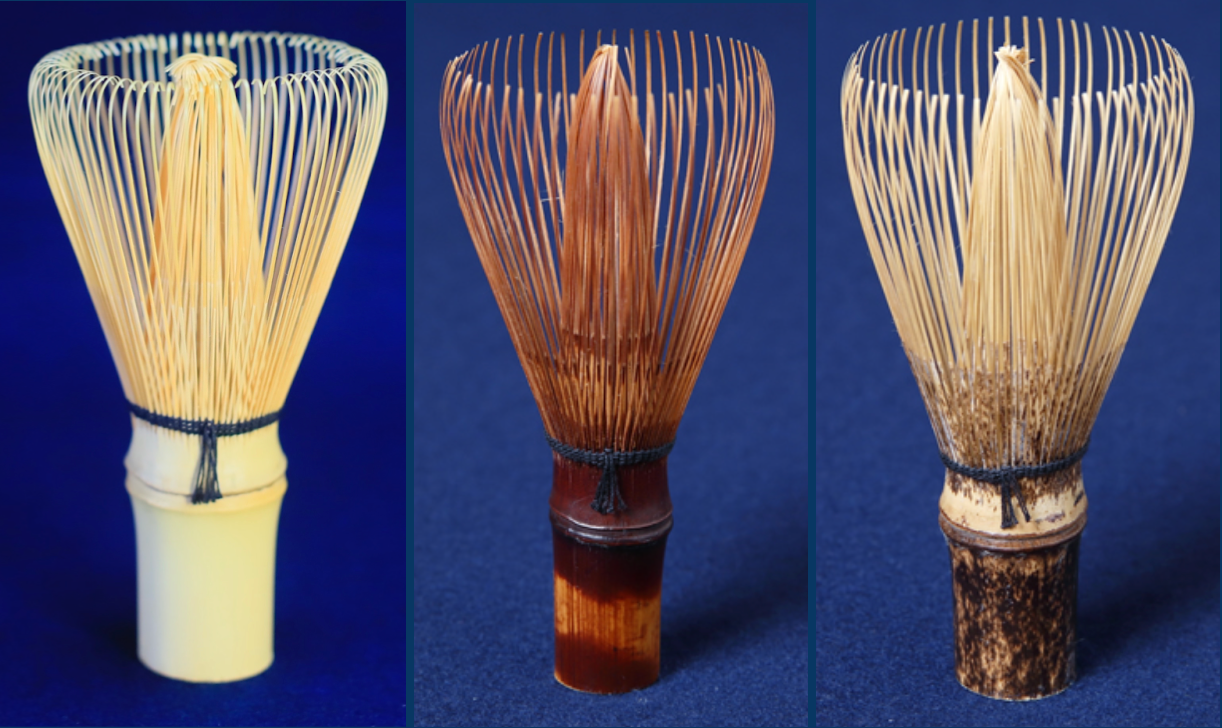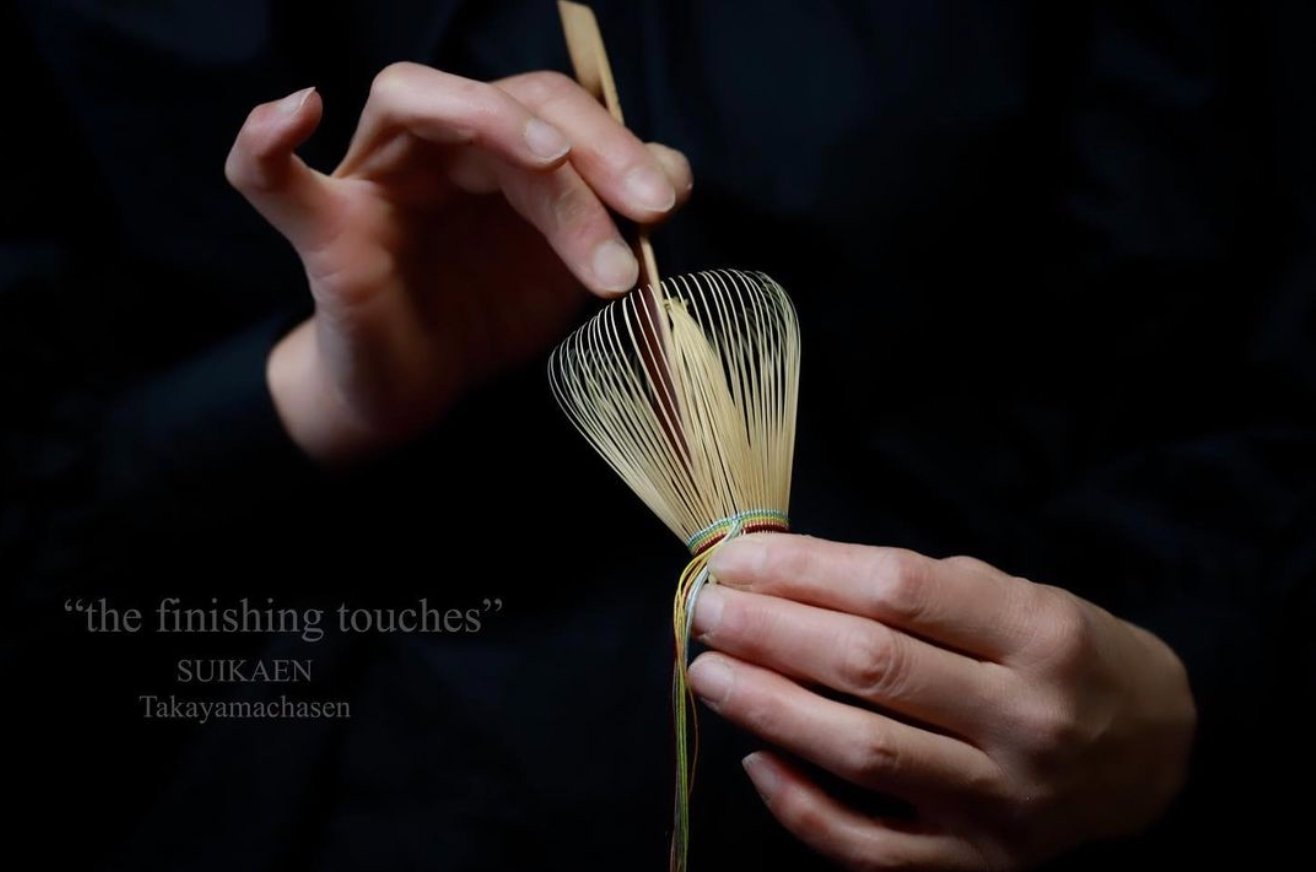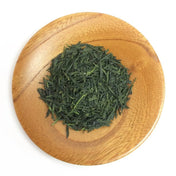Today, I would like to talk about chasen (茶筅), the indispensable and quintessential tea whisk that is used to make matcha, particularly focusing on the bamboo that is used in the art of chasen making. While I imagine most of us take tea whisks for granted, it is quite remarkable how the chasen is able to evenly mix the matcha powder to create a perfectly creamy froth. What is more, I find it neat that a chasen is made from just a single piece of bamboo that is split into 60-120 delicate tines!
History of Chasen Making
To touch briefly on the origins and history of the tea whisk, it is said that in Song dynasty China, a type of tea whisk was used to whip up the diancha (點茶; whisking powdered tea) and this tool was subsequently brought to Japan. There is however, ambiguity with respect to what this whisk looked like or how it was used. The first record of the Japanese chasen dates back to the middle of the Muromachi period (1336 - 1573), when Yoshimasa Ashikaga was the 8th Shogun. According to legend, Japanese chasen craft is said to have started when tea master Murata Jukō requested a top quality chasen from his good friend Sosui Irido, who was the second son of the family controlling Takayama Castle.
Murata Jukō was a priest of Shomyoji temple in Takayama. Not only was Murata Jukō a tea master, he was a well-known master of poetry (master of renga and waka) as well as calligraphy. Today, he is generally regarded as the founder of Wabi-cha, and a major influence on the Japanese tea ceremony. It was not until Murata Jukō moved to Kyoto that this particular tea whisk was presented by Sosui Irido to Emperor Gotomimom at the tea ceremony table. It is said that the emperor thoroughly appreciated the hand-crafted and delicate chasen, giving the chasen the name “Takaho” (Later on it became known as Takayama Chasen). Sosui was deeply moved and pleased by these compliments and thereafter dedicated himself yo the art of chasen making and it became the special craft of the Takayama family.
Since then, chasen craftsmen of Takayama have refined their craft, passing on their mastery through many generations. Today, some chasen masters are of the 18th, or even 25th generation. Unfortunately, like many of the treasured craftsmanship skills in Japan, the art of chasen making is on the decline. In fact, most matcha whisks today are mass-produced outside of Japan (with the majority being made in China). However, those of the highest quality are still made in the small village of Takayama, Nara prefecture, from locally grown bamboo, as they have been for over 500 years. There are roughly 18 chasen masters remaining, who are carrying on their families’ traditions. If you have been up to date with the Yunomi newsletters, this past June, we welcomed Suikaen Tanimura Yasuburo, a 25th generation craftsman onto the Yunomi collection. To prevent this traditional craftsmanship from being lost, these families have even begun taking apprentices from outside of their family.
 Master bamboo whisk craftsman Tanimura Yasuburo of Suikaen in the Village of Takayama, Nara Prefecture.
Master bamboo whisk craftsman Tanimura Yasuburo of Suikaen in the Village of Takayama, Nara Prefecture.
Bamboo, the Root of Chasen Making
First, a few notes about bamboo itself. Bamboo is an evergreen perennial plant in the grass (Poaceae) family. There are about 1,500 bamboo species in the world, and approximately 600 of those can be found in Japan. It can quickly grow tall in warm and humid areas. In fact, in the absence of proper management, as farmers would have traditionally done in rural Japan, many species aggressively spread, and half of the species in Japan are now considered to be invasive.
As bamboo is a grass it does not have a cambium layer like a tree, and the same stem cannot get thicker with each season. A single stem can live for 5-10 years but the whole patch can live for decades, usually until the patch flowers. An interesting fact is that the plants in a bamboo patch bloom in mass, once every 60 - 120 years. When the flowers bloom (a very particular phenomenon), the entire bamboo grove will die, taking about 10 years to recover.
With each season new sprouts, called culms, emerge from the underground rhizome. After the second year, the upward growth of an individual culm slows but the inside of the bamboo (the meat), becomes stronger and harder. Yet, there is a limit to this, and some say it becomes brittle after about 7 years. Thus, most bamboo for craft work is done when the bamboo is between 3 and 7 years. The bamboo used for chasen is typically 3 years old.
Attractive Properties of Bamboo
Bamboo is known to have unique antibacterial and deodorant properties. In Japan, the skin of dried bamboo shoots was used to carry rice balls and utilized at the butcher shop for wrapping meat. Recently, these antibacterial properties of bamboo have even captured interest from the scientific community, with emerging research investigating the antibacterial properties of bamboo extract. With respect to deodorant properties, it is said that wild bears would eat bamboo leaves to hide their smell from their prey. Indeed, it is well-known that pandas who rely heavily on bamboo for their diet tend to have odorless poops. On another note, the strong and supple properties of bamboo are also attractive. This is reflected in how bamboo is used for a wide-array of traditional household products such as chopsticks, cutting boards, scoops, baskets and colanders. These standout properties of bamboo reflect how bamboo is also very well-suited to make chasen.
Types of Bamboo used for Chasen Making
While there are hundreds of bamboo species in Japan, certain particularities are required when it comes to bamboo for chasen. Chasen is generally made by harvesting 3-year old bamboos in the late fall, then sun-drying them for a period of 2 months. This cold weather curing is called 寒干し; “Kanboshi” (i.e., literally meaning “cold-dried”). In Takayama, Nara Prefecture, the traditional home of chasen crafting, cold curing has been a scenic winter tradition for the past 500 years.
 Scenery of bamboos being cold cured, with the snow enhancing the beauty at Suikaen in the Village of Takayama, Nara Prefecture.
Scenery of bamboos being cold cured, with the snow enhancing the beauty at Suikaen in the Village of Takayama, Nara Prefecture.
Just as there are optimal environments suited for making Japanese tea, the gentle sunshine and cool breeze of Takayama (located in a mountain area; Takayama literally means high mountains in Japanese) creates a firm bamboo with a nice shiny glaze. The chasen makers of Takayama select high-quality bamboo that have been grown without the use of any chemicals or fungicides. After going through the winter sun-drying process, as seen in the image, the bamboo is then further dried in the warehouse for an additional 2 years. Bamboos that have been broken or bent during this time period are removed, so the bamboo that is used for making chasen are those that have been carefully selected. In fact, in the process of learning the art of chasen making, one of the first essential skills for the chasen craftsperson is to be able to select these bamboos that will end up becoming chasen.
 The process of placing the selected bamboo in a large pot and boiling them is called “oil extraction”. It is quite a laborious step because of the heat and the heaviness of the bamboo soaked in water. This step cleans the bamboo, removing naturally occurring particles such as dirt. It also removes excess oil in the bamboo, thereby increasing the durability of bamboo. Cold curing will then follow.
The process of placing the selected bamboo in a large pot and boiling them is called “oil extraction”. It is quite a laborious step because of the heat and the heaviness of the bamboo soaked in water. This step cleans the bamboo, removing naturally occurring particles such as dirt. It also removes excess oil in the bamboo, thereby increasing the durability of bamboo. Cold curing will then follow.
The type of bamboo that is utilized determines the final appearance of the whisk. Chasen are typically made from three varieties of bamboo: white (白竹: shiratake), soot (煤竹: susudake), and black (黒竹: kurotake)/purple bamboo. Some are made from madake (真竹: green, or immature bamboo). In the tea whisk images below, one can observe some differences in shape, color, tine finishing curve, as well as central tine binding style.
 A few of Suikaen’s chasens depicting the different types of bamboo that are utilized. From left to right: white, susudake, and kurotake/purple chasen.
A few of Suikaen’s chasens depicting the different types of bamboo that are utilized. From left to right: white, susudake, and kurotake/purple chasen.
The white bamboo is the most common and economic type of bamboo and is well suited for making chasen, due to having smaller but more vascular bundles. The surface is fine, dense, yet easy to break. On the other hand, the black bamboo is the most heavy-duty material for making a matcha whisk. Due to its high density, it is extra difficult to carve. It is more durable though, and can last 3 times longer than a regular white bamboo chasen. The soot bamboo is a unique and rare bamboo because it is bamboo that has been stained by smoke from cooking fires over many decades, even centuries (100-200yrs)! In traditional Japanese houses, these bamboo stalks were used in thatched roofs. The bamboo stalks over and near the hearths (囲炉; irori) of these houses were gradually stained into a unique and natural brownish color, and when these roofs were replaced, the bamboo were sold to tea whisk craftsman to be made into high quality chasen whisks and chashaku scoops. They are now considered to be very rare and precious. As the number of traditional Japanese houses are on the decline, this type may unfortunately disappear with time.
The Art of Chasen Making
Now that we have touched on the history of the chasen as well as the bamboo used in chasen making, we will finally get into the details of how the chasen takes its beautiful shape and form. After the drying of the bamboo, there are approximately eight steps taken that transform the raw material into a delicate tea ceremony tool. A traditional chasen craftsman makes each chasen by hand with a small knife and a couple special tools, also made of bamboo, of course!
 Visual of the steps involved in chasen making by Suikaen. One may also enjoy a video of the process.
Visual of the steps involved in chasen making by Suikaen. One may also enjoy a video of the process.
1. Haratake (原竹): The very first step is to cut the bamboo into 12cm (4.5 inches) long segments with the node about one third down the length, splitting the bamboo into two sections (see the very first step in the image above). The longer side will be the side with the tines and the shorter side will become the handle.
 The first Haratake step: the selected bamboos are being cut for the length of making chasen.
The first Haratake step: the selected bamboos are being cut for the length of making chasen.
2. Katagi (片木): In the subsequent step called katagi, the tea whisk craftsman will begin to form the tines by shaving the outer layer of skin from the halfway point of the tine side towards the tine tip end. From here, the tine side is split half-way down into 16 segments. Then the craftsman bends each segment back, and using a knife, splits the hard outer skin from the soft inner flesh, which is removed.
3. Kowari (小割): Refers to further splitting of tines. Depending on the style of the chasen, the 16 segments are split even more, anywhere between two to eight times. This results in chasen with between 36 and 120 tines. Note that the art of delicately cutting the bamboo into 80-100 fine tines (each less than 0.1mm at the thinnest point) requires a lot of concentration, skill and hard work. In fact, even a skilled craftsman can only produce around 6 or 7 chasen per day.
4. Aji-kezuri (味削り): After all of the tines are cut, the whisk is then soaked in hot water to soften the bamboo. The craftsman will shave the tines, tapering them from base to the tip, with the final 1-2cm of the tines becoming thin, flexible, and translucent. These flexible tips will then be curled inwards to create their distinctive and delicate shape. This is one of the most essential steps, which requires years of practice and training. In fact, the additional tine flexibility that a craftsman gives to a chasen contributes a lot to forming foam in matcha!
 Image capturing Suikaen's Tanimura Yasaburo’s workspace. It is said that the taste of matcha depends on this aji-kezuri step. The small knife in the image above is the only instrument that is utilized in this process. Before this meticulous step, the master will always start by sharpening the small knife.
Image capturing Suikaen's Tanimura Yasaburo’s workspace. It is said that the taste of matcha depends on this aji-kezuri step. The small knife in the image above is the only instrument that is utilized in this process. Before this meticulous step, the master will always start by sharpening the small knife.
5. Mentori (面取り): The craftsmen will then shave minute amounts of material from the long edges off of each individual tine, removing rough edges. This helps prevent matcha from sticking to the tines.
6. Shita-ami (下編): After the tines are shaved, they are separated into inner and outer rings by a string of thread that weaves back and forth around the tines so that half of them are in the inner circle and the other half form the outer circle.
7. Ua-ami (上編) x 2 : Two additional rows of threading are added to secure everything in place and a knot is tied at the front of the whisk. This threading is most commonly black, but different colors can be used for various effects and occasions.
8. Shiage (仕上げ): The craftsman fine tunes the whisk’s tines (which are all splayed out at this point), forming them into their final shape. This step often involves twisting the inner tines into a knot. Finally, the finishing touches and inspection is performed by the lead craftsman, who makes sure that all the tines are evenly spaced and form an even circle.

Unlike mass-produced matcha whisks, Takayama chasen are entirely handmade, without the use of machines or chemicals. Before learning about the art of chasen making, it never crossed my mind to think that the initial process started out by the careful selection of bamboos which were then cold cured in the winter time... While I have yet to dance with a Takayama chasen in making matcha (I very much look forward to doing so!), I now have a deeper appreciation for the intricacy that is required in traditional chasen making.
All photos from this blogpost were provided by Suikaen (翠華園), the atelier of master bamboo whisk craftsman Tanimura Yasuburo in the Village of Takayama of Nara Prefecture. Follow their Instagram account to keep up to date with their beautiful and delicate craftsmanship.


